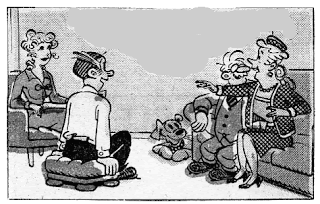There is a droll quality hovering around conceptual art which I can't resist or dismiss. I detect a tongue-in-cheek approach by the artists who practice it and I suspect they are proud of the fact that while the lay person regards it as a joke, the authorities treat it seriously - promote it, sponsor it, write about it, and buy it. Conceptual art at its best is audaciously entertaining.
Here are a few examples of conceptual art:
One artist took a pencil drawing by another artist and erased it. The result, a piece of white paper, was exhibited as a work of art, most likely with an explanatory caption, by the one who did the erasing.
An artist put up a barricade of oil drums, blocking a narrow street in Paris. He declared that the resulting traffic jam was the work of art, not the oil drum barricade.
Another artist taped a piece of paper to his studio wall and claimed to have contemplated it and concentrated on it for a total of 1,000 hours over a period of years. Then it was exhibited, with its explanation, as a work of art.
A Dutch artist, whose work was concerned with movement and measurements and walking, announced that his one man show consisted of all the shoe stores in Amsterdam.
A major British museum bought and showed a sculptor's work which was 120 paving bricks arranged in a rectangle on the floor.
These works of conceptual art and hundreds more like them have some things in common. First, they were all created by brilliant, college-educated individuals who achieved wealth and solemn recognition from critics, dealers, other artists, museum curators, writers and art collectors worldwide. Second, none of the pieces has to necessarily be seen to be appreciated; a written description is enough. We know what a traffic jam, a shoe store,10 dozen bricks and a blank piece of paper look like. A third thing they share is that they are all clever and original ideas which were written down, acted out or otherwise made concrete. There are people and institutions willing to pay well for these original concepts; there is always a demand for the new and offbeat.
It seems easy - try it. The best of conceptual art is very much like a stunt, meant to amuse, provoke, or otherwise entertain in order to promote the artist, the gallery or museum, and modern art in general. Great skill and judgment is required to create an effective stunt.
A parallel exists in the advertising business. The creative people who write, for instance, such simple phrases as these are well paid and much respected:
"Tide's in; dirt's out." "Like a good neighbor, State Farm is there." "When you're out of Schlitz, you're out of beer." "Ban won't wear off - as the day wears on."
Many scoff at the slickness and gullibility of the highbrows who create or promote or pay for conceptual art. I suggest looking at the phenomenon in a broader way.
This is one of my favorite original, creative ideas: I don't know who wrote it, but he stated that the answer to a particular challenge was "Kareem Abdul Jabbar." The challenge was "Describe the sound of a fat lady taking off her girdle."

























































